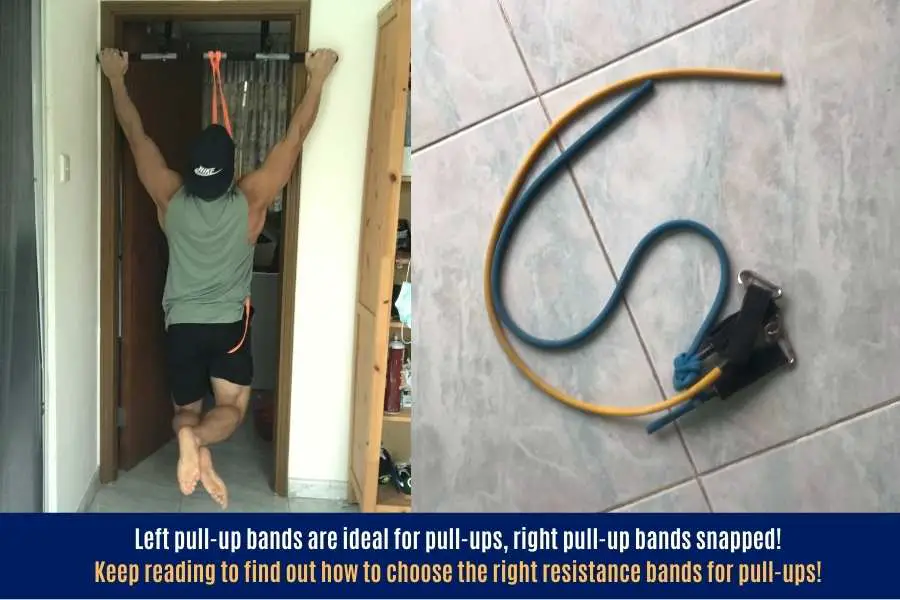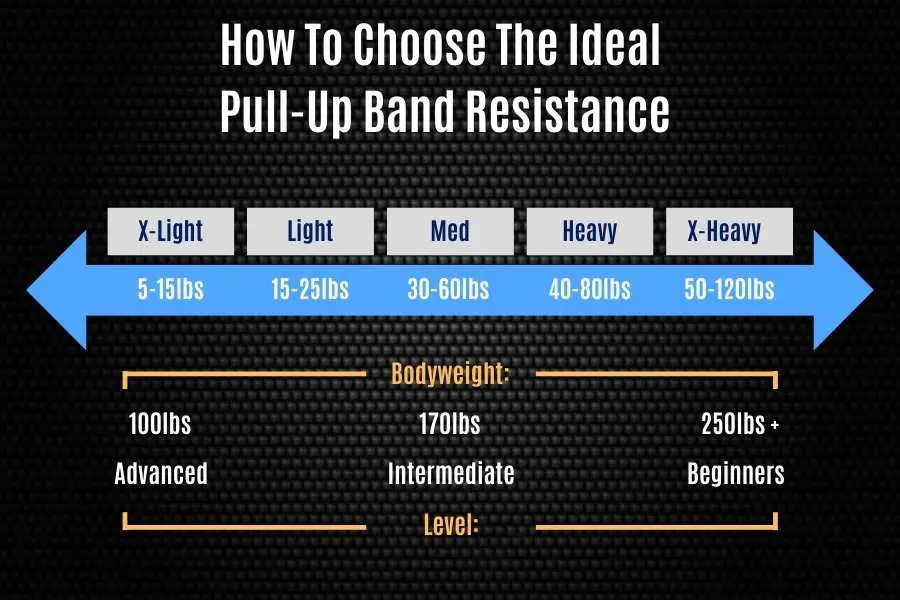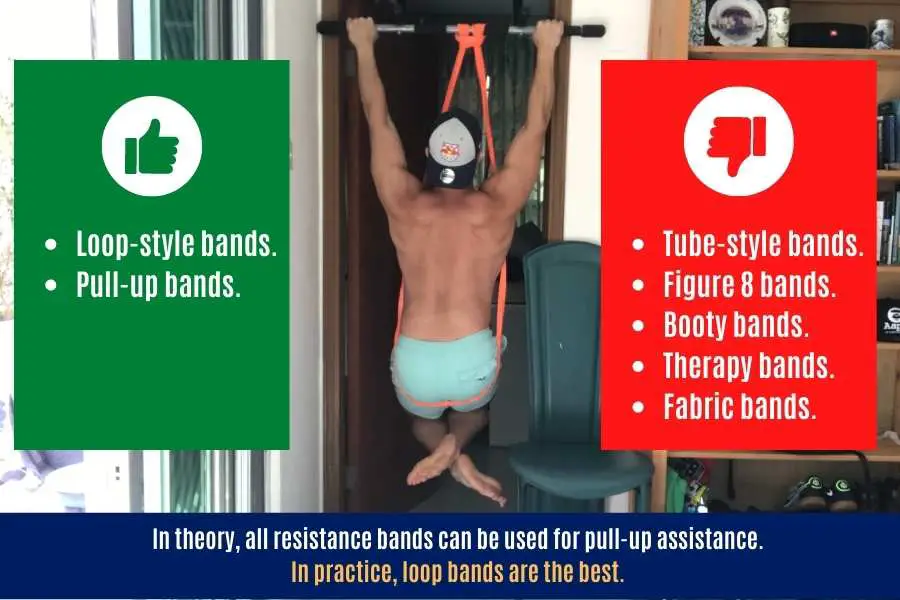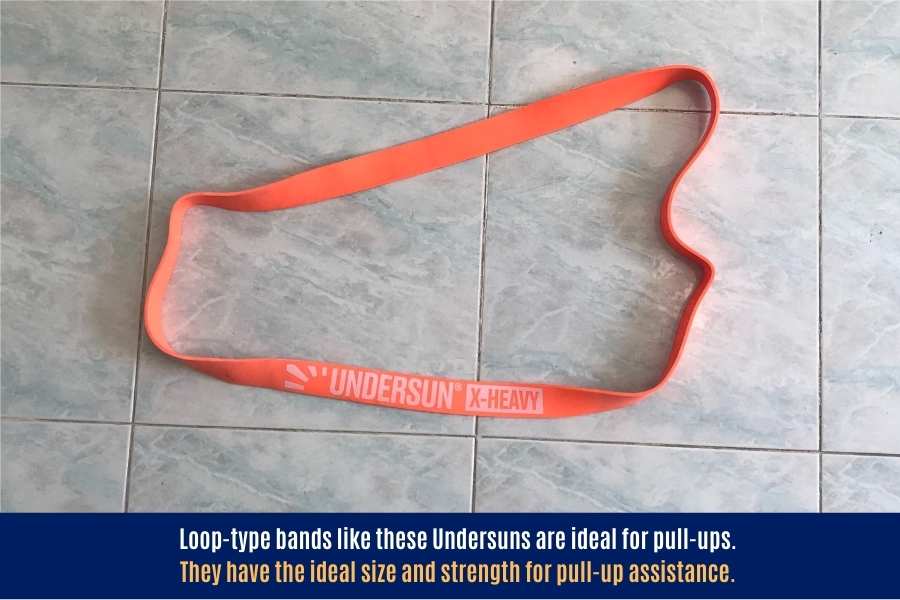Resistance bands can be extremely beneficial for providing pull-up assistance; but only if they are chosen correctly. If the band is too big or light it won’t give you enough assistance. And if it’s too small or heavy, it’ll give you so much assistance that there’s not much point in doing the exercise at all! This post explains how to choose pull-up bands and resistance bands for pull-ups.
Pull-up bands should be a loop-style shape of around 40-inch length. The average beginner should use a light-medium band providing 15-60lbs of resistance. However, heavier people and those who have weak upper body strength may need to use heavier bands.
Pull-up bands helped me master my first unassisted pull-up.
Below, I’ll explain exactly how to choose the ideal bands for you to do the same!
I’ve also included a pull-up band assistance chart to help you decide on the exact band strength for your personal needs.
I hope it helps!

How To Choose Resistance For Pull-Up Bands
An average beginner requires 15-60lbs of resistance from a pull-up band. However, the amount of assistance required from a band is affected by the person’s body weight, goal, and training level. Heavier beginners who cannot do a pull-up require heavier bands.

It’s important to realize there’s no one-size-fits-all when it comes to choosing the ideal pull-up band.
That’s because we all have different starting strengths, experiences, and body weights.
We also have different goals.
Where a beginner may be aiming to master their first unassisted pull-up, an intermediate may be interested in increasing their rep number or range of motion (more on this next).
With that being said, the chart below is my best effort at giving you a guideline on how to choose the ideal resistance for a pull-up assistance band.
Here is the pull-up band assistance chart:
| Pull-Up Band Classification | Pull-Up Band Resistance | Goal | Bodyweight | Training level |
|---|---|---|---|---|
| Extra-heavy | 50-120lbs | Unassisted pull-ups | 250lbs+ | Beginners |
| Heavy | 40-80lbs | Unassisted pull-ups | 190 to 250lbs | Beginners |
| Medium | 30-60lbs | Unassisted pull-ups | 150 to 200lbs | Beginners to intermediates |
| Light | 15-25lbs | Increase pull-up reps and ROM | 150 to 200lbs | Beginners to intermediates |
| Extra light | 5-15lbs | Increase pull-up reps and ROM | 100 to 150lbs | Intermediates to advanced |
Next, I’ll explain how to use this table to choose the ideal resistance/strength for your pull-up bands.
Using The Table To Choose Your Ideal Resistance Bands For Pull-Ups
The table works on a spectrum.
The idea is to determine your metrics (goal, bodyweight, ability) and match yourself to the given range of pull-up band resistance levels.
Here’s how to decide on each metric:
What’s your goal?
- To perform unassisted pull-ups. If you cannot currently do a pull-up and aim to master your first unassisted pull-up, then you should choose a relatively heavy band. This will assist in reducing your body weight and allow you to practice the movement without the unmanageable weight.
- To increase rep number or range of motion. If you can currently do pull-up reps but want to increase your rep number, or if you want to increase your range of motion (ROM), then you should choose a relatively light band. The aim is to provide slight assistance such that the movement is still challenging but still allows you to increase your overall reps and training volume.
What’s your body weight?
- 100-150lbs. Women in this weight range would typically be considered average. Men in this weight range would typically be considered slightly underweight. Choose a lighter resistance band to provide a good amount of assistance for your pull-up.
- 150-200lbs. Women in this weight range would typically be considered overweight. Men in this weight range would typically be considered average. Choose a medium resistance band to provide a suitable amount of assistance for your pull-ups.
- 250lbs+. Both women and men in this weight range would usually be considered overweight. I would recommend you choose heavy resistance bands for pull-up assistance.
Disclaimer: these weight classifications should be taken with a grain of salt as bodyweight classification is also based on your BMI and height.
What’s your training level?
- Beginner. You have just started practicing pull-ups and cannot currently perform a single rep without assistance. Choose medium to heavy resistance bands to provide pull-up assistance and progress onto unassisted pull-ups.
- Intermediate. You have practiced pull-ups for 1 to 2 years and can do around 5-to 10 unassisted reps. Choose medium to light resistance bands to provide a good amount of pull-up assistance to increase reps and ROM.
- Advanced. You have practiced pull-ups for more than 2 years and can do around 10-20 unassisted reps. Choose light resistance bands to provide pull-up assistance to increase reps and ROM.
Now you can match your metrics to a respective band resistance for assisted pull-ups.
You may find yourself landing in the middle of two-band weights e.g. medium and heavy.
In this situation, I would suggest you choose the lighter band out of the two (i.e. medium) because it’s generally better to under-assist than it is to over-assist.
Next, I’ll explain how to choose the ideal size and dimensions for your pull-up bands.
If you’re not sure why bands are given as a weight range, you can check out my other post which explains what the weight means on a resistance band!
The Ideal Size For Pull-Up Bands
It’s not just the strength of your resistance bands that are important for effective pull-up assistance.
Dimensions are also important.
Here is how to choose the ideal dimensions for a set of pull-up resistance bands:
| Length: | 38-42 inches |
| Circumference: | 76-84 inches |
| Width: | 0.3-2.0 inches |
| Thickness: | 0.2 inches |
And here’s why it’s important to choose the correct pull-up band dimensions:
- 38-42 inch length. For a resistance band to be suitable for banded pull-ups, it needs to be long enough to wrap around the bar and your legs without overstretching (which can cause them to snap). But it can’t be too long either since this would reduce tension and pull-up assistance.
- 76-84 inch circumference. The above pull-up band length recommendations translate into this circumference. Allows you to comfortably insert your leg through the loop as you set up the banded pull-up.
- 0.3-2.0 inch width. This will vary depending on the strength of the resistance bands chosen for pull-ups. But generally speaking, you want your bands to be within this range. Heavier bands are usually wider.
- 0.2-inch thickness. An adequate thickness is essential. Bands are stretched and stressed to great degrees during pull-up assistance. You want a band that’s thick enough to handle this stress without tearing and snapping.
If you want to avoid choosing the wrongly sized band for your pull-ups, you may be interested in my other article which explains how to choose the right band length and size for pull-ups.
Can You Use Regular Resistance Bands For Pull-Ups?
Regular resistance bands can generally be used for pull-ups. However, the bands must have the correct dimensions to be safely and effectively used for pull-up assistance. Using an unsuitable band size can cause it to snap during the exercise.

When you understand how banded pull-ups work, you’ll realize that a band doesn’t necessarily have to be labeled as a “pull-up band” to be used for pull-ups.
Any kind of elastic device can assist with pull-ups if they fit safely around your legs and the bar.
Therefore regular resistance bands CAN be used for pull-ups.
With that said, it’s important to choose the right strength and size resistance band to ensure it is safe and effective for performing pull-ups (follow the above recommendations).
Additionally, you should know that certain types of resistance bands are more suitable than others for pull-ups (see next).
What Type Of Resistance Band You Should Use For Pull-Ups
Loop-style resistance bands are the best for pull-ups. These are long enough to wrap around the user’s leg and the bar. Additionally, loop bands are usually stronger than the other types of bands, making them ideal to be used for pull-up assistance.

Below, I share how well each type of band performs for pull-ups and why loop-style bands are generally the best.
The following types of band work well with pull-ups due to their shape, size, and strength:
- Pull-up bands. These are usually the same shape as loop-style bands but stronger.
- Loop-style bands. These are flat and circular with enclosed ends that allow them to loop around your leg.
These types of bands can be used for pull-ups but are prone to snapping (i.e. not very good):
- Tube-style bands with handles. These come in a variety of different colors and weights and are usually shorter and not as strong or durable as loop bands.
The bands below are unsuitable for pull-ups due to their shape and size:
- Figure 8 bands. These are too small to be used for pull-ups and you risk snapping them.
- Booty bands. These are mini loop bands that are also too small.
- Rubber therapy bands. These have open ends that don’t allow you to safely loop them around your legs.
- Circular fabric bands. Just like booty bands, these are too small.
You can check out my other post for more information on what pull-up asssitance bands are and how to use them!
Best Pull-Up Bands On The Market
| Product | Brand | Description | Prime | Buy |
|---|---|---|---|---|
Top Top
Top
Top
Top
Top
Top | Undersun | BEST OVERALL Circular loop band set with 5x weight increments for beginenrs and advanced lifters to build muscle at home (bundled with door anchor and travel pouch) | PrimeEligible | Check Amazon Price |
 Top
Top
Top
Top
Top
Top Top
Top
Top
Top
Top
Top | Iron Infidel | Circular loop band set with 5x weight increments. No door anchor and less durable than Undersun. But a portion of their profits is donated to the Wounded Warriors Foundation for injured war veterans | PrimeEligible | Check Amazon Price |
 Top
Top
Top
Top
Top
Top Top
Top
Top
Top
Top
Top | WODFitters | Budget circular loop bands that can be purchased as single bands | PrimeEligible | Check Amazon Price |
 Top
Top
Top
Top
Top
Top Top
Top
Top
Top
Top
Top | Whatafit | BEST BUDGET tube bands with handles. Cheap and affordable for beginenrs but do not provide the same weight or durability as circular loop bands. | PrimeEligible | Check Amazon Price |
 | Theraband | Alternative bands for seniors. Extremely affordable but light resistance bands for general fitness workouts. | PrimeEligible | Check Amazon Price |
 Top
Top
Top
Top
Top
Top Top
Top
Top
Top
Top
Top | Boss Fitness | Door anchor replacement for unlocking exercise angles to isolate different muscle regions like the upper chest | PrimeEligible | Check Amazon Price |
 Top
Top
Top
Top
Top
Top Top
Top
Top
Top
Top
Top | Ihuan | Ventilated microfibre-neoprene workout gloves to protect hands from friction burns generated by resistance bands | PrimeEligible | Check Amazon Price |
Taking all factors into consideration, here are the best pull-up bands you can currently buy in my opinion:

If you want the best:
Undersun Fitness band set (you can follow this link for the cheapest price).
Why:
I’ve been using these bands for just over 2 years now and highly recommend them. Not only are these bands the right size for pull-ups, but they also come in 5 different strength levels.
This makes them ideal for progression in people of all abilities since you can work your way from the heaviest band (most assistance) to the lightest band (least assistance).
The different band increments also mean they can be used for a variety of resistance band pull-up replacement exercises that mimic the same muscle activation as pull-ups.
These exercises are ideal for people who want to work the pull-up muscles without actually having to do pull-ups.

If you want something cheap and cheerful:
Sunpow Pull-up bands (you can follow this link for the cheapest price).
Why:
These resistance bands are also the ideal size and dimension to wrap around a bar and your legs.
As such, they are safe and effective to be used for banded pull-ups.
However, you don’t get the same number of weight increments as the Undersun bands.
Therefore these bands aren’t as versatile as the Undersuns and progression won’t be as smooth since you’ll be jumping between more extreme weight differences between each band.
With that being said, these bands are half the price and great for someone who’s on a budget!
Conclusion
I’ve explained how to choose pull-up bands and resistance bands for pull-ups.
The most important thing to consider is the strength and size of the band.
Ideally, you want to use a resistance level that helps you to accomplish your goals.
Most people looking to buy pull-up bands are beginners who are interested in mastering unassisted pull-ups.
If that’s you, then light-medium bands that give 15-60lbs of resistance are generally enough.
But heavier people might need to use heavier bands (refer to my pull-up band assistance chart).
Additionally, I would recommend using circular loop-style bands
These are large enough to wrap around the bar and your legs, but not so large that the band is slack (see the post for exact size recommendations).
What resistance will you be using for your pull-up bands?
Feel free to send me a message if you have any questions! You can find my details on the “contact us” page.
You may also be interested in the downloadable Kalibre Blueprint PDF which details exactly how I gained 40lbs of lean muscle (it’s 100% free!). It details the exact exercises and nutrition (with printable worksheets) I used to go from skinny to ripped!
Thanks for reading guys!
Peace Out,
Kal
(Biochemistry BSc, Biomedical Sciences MSc, Ex-Skinny Guy)


